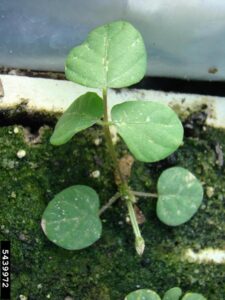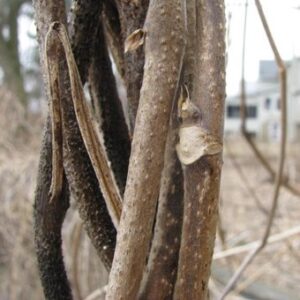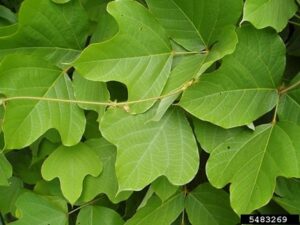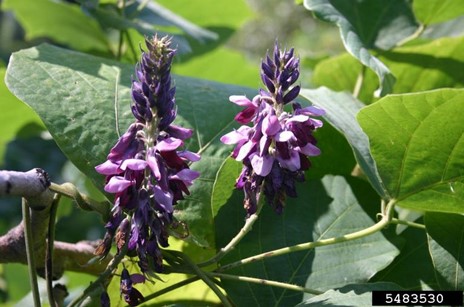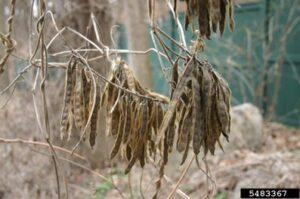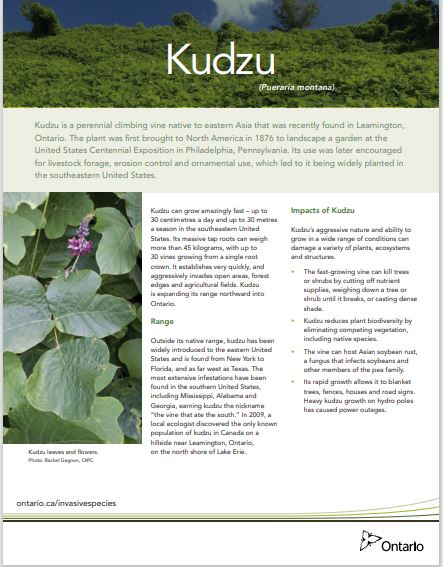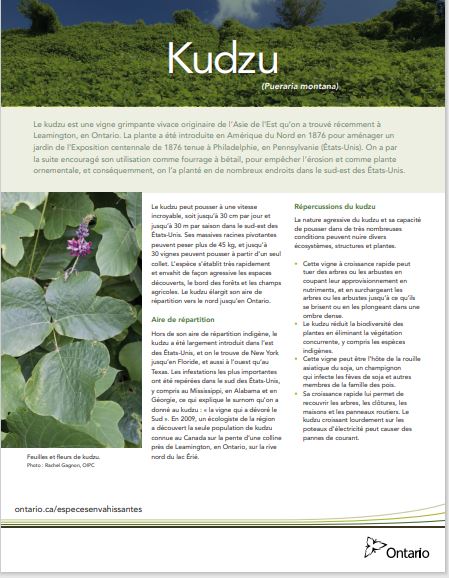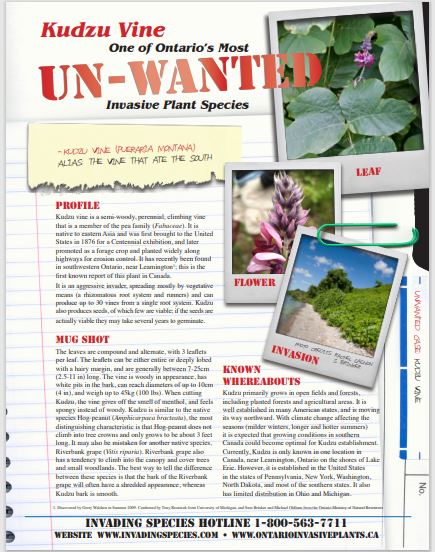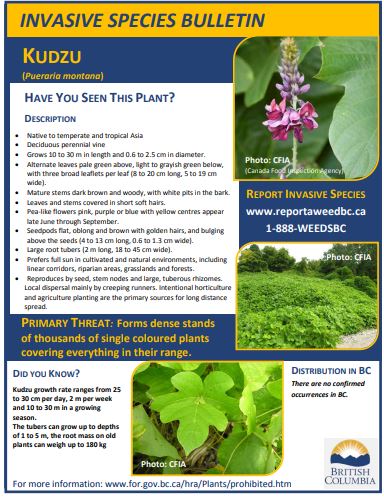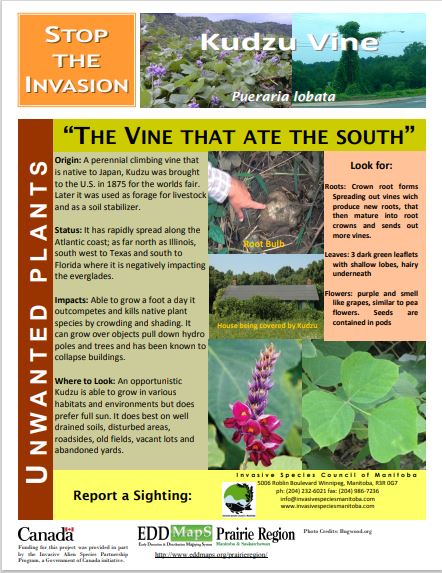Kudzu (Pueraria montana)
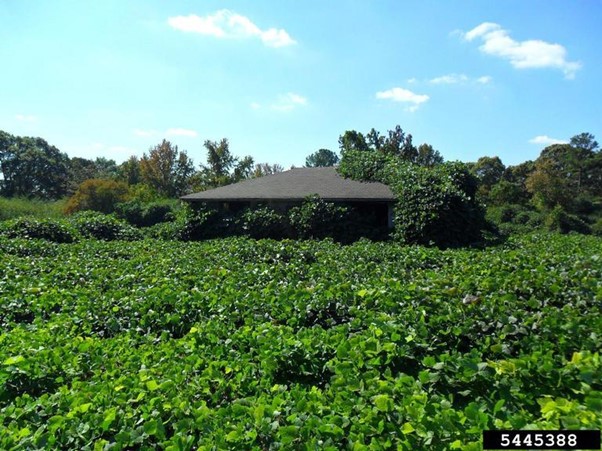
Kudzu
Photo: David Stephens, Bugwood.org,
French common name: Kudzu
Order: Fabales
Family: Fabaceae (pea)
Did you know?
Kudzu was intentionally introduced to North America as an ornamental plant and later promoted for use as livestock forage and planted for erosion control.
Kudzu is an invasive climbing vine native to eastern Asia that can have devastating ecological and economic impacts. It grows rapidly and will cover almost anything in a thick blanket of leaves and vines that blocks out sunlight, smothers native plants and causes damage to buildings. The invasion and spread of kudzu in Canada would pose a serious threat to the Canadian agriculture and timber industries, and would be extremely costly to manage.
The only known population of kudzu in Canada was discovered in 2009 near Leamington, Ontario.
In Canada, kudzu is regulated as a pest under the Plant Protection Act and is a prohibited noxious weed by the Weed Seeds Order, 2016 under the Seeds Act.
Kudzu is a semi-woody, perennial, climbing vine with stems that can grow 10-30 m in length. Young stems of kudzu are yellow-green, while mature stems are dark brown, woody, and marked by white pits. Mature stems can grow to be 10 cm in diameter and weigh up to 45 kg (100 lbs). Despite their woody appearance, the vines feel spongy when cut and give off a menthol smell.


Images:
Left -Kudzu seedling, image credit: Rebekah D. Wallace, University of Georgia, Bugwood.org
Right -Mature Kudzuu stem, image credit: Leslie J. Mehrhoff, University of Connecticut, Bugwood.org
The tuberous roots of kudzu can grow to be 2 m long and 18 to 45 cm wide. This plant has alternating compound leaves, each composed of three leaflets that are green and 7 to 25 cm long.

Image -Kudzu leaves, image credit: Leslie J. Mehrhoff, University of Connecticut, Bugwood.org
Kudzu flowers are reddish-purple in colour and look like those of a pea plant. The flowers grow in fragrant, hanging clusters in late summer and the resulting seed pods are flat, brown, and hairy, each containing 3 to10 seeds.


Images: Kudzu flowers
Left image credit: Leslie J. Mehrhoff, University of Connecticut, Bugwood.org
Right image credit: Peggy Greb, USDA Agricultural Research Service, Bugwood.org

Image: Kudzu seed pods. Image credit: Leslie J. Mehrhoff, University of Connecticut, Bugwood.org
Look-Alikes
Native hog-peanut (Amphicarpaea bracteata) may be confused for kudzu, however, unlike kudzu, hog-peanut only grows to about 3 feet long and does not cover trees. The flowers of these two plants also differ, hog-peanut flowers are pale violet or white, compared to the reddish-purple flowers of kudzu.
Kudzu is able to grow in a wide range of conditions and is tolerant of most soil types. This plant thrives in areas with full sunlight, such as the edges of forests, open fields, and along roadsides and highways.
An aggressive invader, kudzu spreads rapidly by vegetative expansion. Runners, rhizomes and vines spread from existing plants and grow roots at their nodes to create new plants. This invasive plant can grow up to 30 cm (1ft) per day, and up to 30 m (90ft) each growing season.
Kudzu is nicknamed “the vine that ate the south” due to the extensive infestations in the Southern United States, including Mississippi, Alabama, and Georgia.
The only known population of kudzu in Canada is located on the north shore of Lake Erie, near Leamington, Ontario. It was discovered in 2009 by a local ecologist and eradication efforts began taking place in 2015 to prevent further spread. (Caton, 2021)
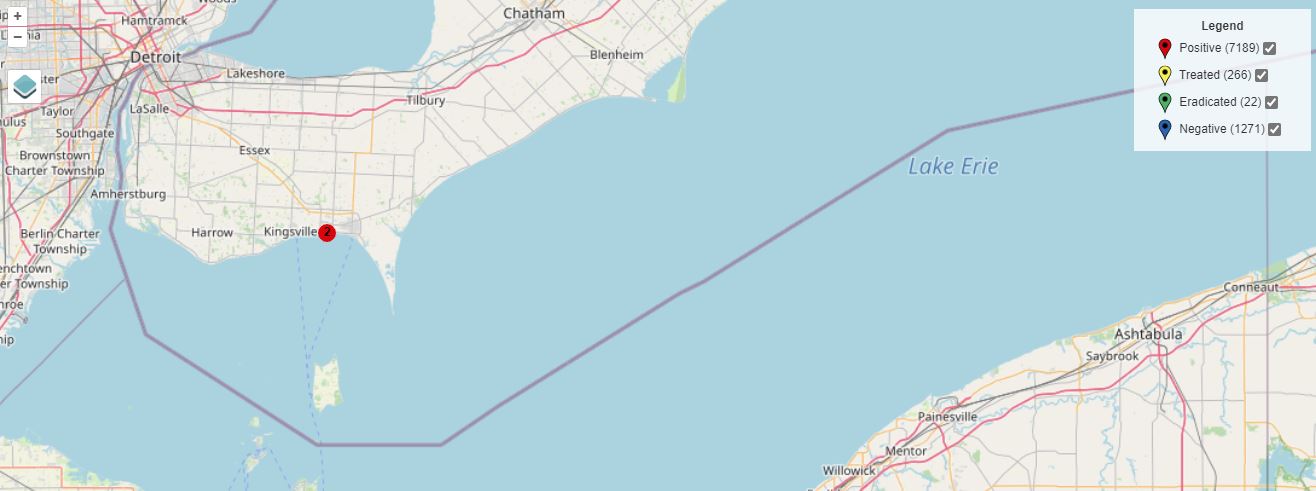
Kudzu distribution via EDDMapS (2023).
Environmental:
Kudzu grows quickly and densely, forming a thick mat of vines and leaves that covers native vegetation as well as human-made structures. Kudzu outcompetes and kills native plants by blocking sunlight and preventing photosynthesis. This vine can choke out trees and shrubs, break branches and the weight of the vines can even uproot entire trees. An infestation of kudzu can lead to a loss of biodiversity and resulting cascading effects on an ecosystem.
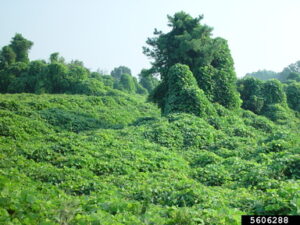
Economic:
Kudzu can grow over and completely cover anything in its path, including trees, hydro poles, fences, houses, and road signs. It can cause structural damage to buildings and cause power outages when it grows over poles and interferes with overhead power lines.
This plant has the potential to be incredibly detrimental to Canada’s agriculture and timber industries as it can smother fields of produce and kill trees.
Kudzu can also be a host to soybean rust–a serious plant disease that affects soybeans and other legumes and can result in significant crop loss.
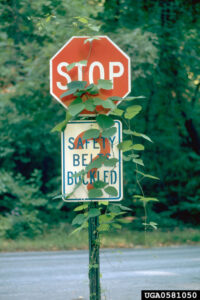
Social:
Infestations of kudzu can lessen the natural beauty of an area and be a hindrance to outdoor recreational activities such as hiking, biking, and hunting.
Research suggests that the spread of invasive kudzu can lead to increased emissions of nitric oxide and an increase in ozone pollution. (Hickman et al., 2010)
Prevention
Prevention is key to preventing further introduction and infestation of this highly invasive and damaging plant. To help prevent the spread of invasive plants:
- Avoid planting invasive plants, instead buy non-invasive plants from reputable sellers for use in gardening and landscaping.
- When walking or hiking, stay on trails and keep your pets on a leash. Before leaving an area, use a boot brush to clean your shoes and other gear to get rid of any invasive plant seeds or parts.
- Avoid moving soil or plants from natural areas; not only would you be disturbing an ecosystem but you may accidentally spread invasive plants and seeds.
- Before travelling to new areas, especially if you have been in an area where kudzu or other invasive plants have been identified, clean vehicles and equipment well to remove dirt and debris that may hide invasive hitchhikers.
- Dispose of pulled and cut invasive plants in black garbage bags and let them sit in the sun on a hard surface for at least a week. Don’t discard invasive plants in the compost or natural areas as this may lead to further spread.
Reporting
Learn how to identify kudzu and if you think that you’ve found it, please report your sightings to EDDMapS or call the Invading Species Hotline at 1-800-563-7711.
Management
Due to its fast growing and resilient nature, kudzu is difficult to manage once it has been established.
Control measures such as hand pulling and cutting, mowing, tarping, controlled burns, and herbicides have been used to help manage kudzu. Another measure of control is to let grazing animals such as goats and pigs feed on the plant.
Research has been conducted to evaluate the effectiveness of biological controls, such as some fungi species, to manage invasive kudzu. (Boyette et al., 2001)
Factsheets
Research
Boyette, C. D., Walker, H. L., & Abbas, H. K. (2001, May 24). Biological Control of Kudzu (Pueraria lobata) with an Isolate of Myrothecium verrucaria. ARS Home : USDA ARS. https://www.ars.usda.gov/ARSUserFiles/64022000/Publications/Boyette/Boyette%20et%20al%2002%20BST%2012.pdf
Harron, P., Joshi, O., Edgar, C. B., Paudel, S., & Adhikari, A. (2020, March 16). Predicting Kudzu (Pueraria Montana) spread and its economic impacts in timber industry: A case study from Oklahoma. PubMed Central (PMC). https://www.ncbi.nlm.nih.gov/pmc/articles/PMC7075552/
Hickman, J. E., Wu, S., Mickley, L. J., & Lerdau, M. T. (2010, May 17). Kudzu (Pueraria Montana) invasion doubles emissions of nitric oxide and increases ozone pollution. PubMed Central (PMC). https://www.ncbi.nlm.nih.gov/pmc/articles/PMC2890437/
References
Asian soybean rust – Phakopsora pachyrhizi. (2012, January 25). Canadian Food Inspection Agency / Agence canadienne d’inspection des aliments. https://inspection.canada.ca/plant-health/invasive-species/plant-diseases/asian-soybean-rust/eng/1327501711301/1327501824978
Caton, M. (2021, May 13). Leamington site of invasive kudzu vine shrinking. Windsor Star. https://windsorstar.com/news/local-news/leamington-site-of-invasive-kudzu-vine-shrinking
Invading Species. (n.d.). Kudzu. Ontario’s Invading Species Awareness Program |. https://www.invadingspecies.com/invaders/plants/kudzu-2/
King, C. (2015, June 8). Soybean rust monitoring. Top Crop Manager. https://www.topcropmanager.com/soybean-rust-monitoring-17291/
Kudzu – Pueraria Montana. (2019, May 14). Canadian Food Inspection Agency / Agence canadienne d’inspection des aliments. https://inspection.canada.ca/plant-health/invasive-species/invasive-plants/invasive-plants/kudzu/eng/1331750489827/1331750551292
Kudzu (Pueraria montana var. lobata) Restricted Invasive Plant. (2020, June). Department of Agriculture and Fisheries, Queensland. https://www.daf.qld.gov.au/__data/assets/pdf_file/0003/49665/kudzu.pdf
Kudzu harms air, not just ecosystems, says study. (10, May 18). The Earth Institute – Columbia University. https://www.earth.columbia.edu/articles/view/2695
Kudzu Vine: One of Ontario’s Most Unwanted Invasive Plant Species. (2016, July). Ontario Invasive Plant Council. https://www.ontarioinvasiveplants.ca/wp-content/uploads/2016/07/unwantedlettersKudzuPRINT1.pdf
The vine that ate the south is here! (2009, September 22). Ontario Federation of Anglers and Hunters. https://www.ofah.org/2009/09/the-vine-that-ate-the-south-is-here/
Weed of the Week: Kudzu (Pueraria montana). (2004, October 12). Invasive.Org. https://www.invasive.org/weedcd/pdfs/wow/kudzu.pdf

